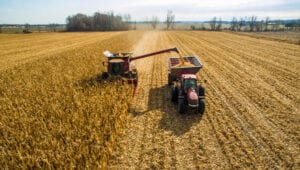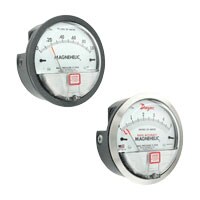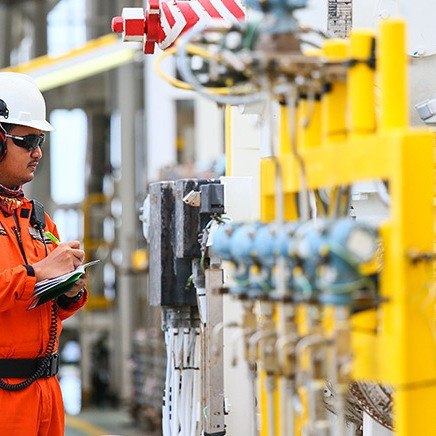Pressure Measurement's Role in Corn Husking
 Corn processing is a major industry in the United States – a CORNerstone, if you will, of the United States’ agricultural sector. All joking aside, the United States is the largest producer of corn globally, and corn is a cash crop that is processed into a wide range of products we use every day – including being processed for the food and beverage industry, as livestock feed, and in ethanol production. How is Corn Harvested? Back in the day, farmers picked and husked their corn by hand. In time, corn huskers were invented to quickly remove the husks and other debris from the corn. This worked well for a while – especially for small and medium-sized processing operations – but as operations ramped up, technology also needed to improve.
Corn processing is a major industry in the United States – a CORNerstone, if you will, of the United States’ agricultural sector. All joking aside, the United States is the largest producer of corn globally, and corn is a cash crop that is processed into a wide range of products we use every day – including being processed for the food and beverage industry, as livestock feed, and in ethanol production. How is Corn Harvested? Back in the day, farmers picked and husked their corn by hand. In time, corn huskers were invented to quickly remove the husks and other debris from the corn. This worked well for a while – especially for small and medium-sized processing operations – but as operations ramped up, technology also needed to improve.  Today, in the age of large-scale industrial farming, corn is typically harvested with the use of a combine, which is a machine that combines reaping, threshing, and gathering into a single, efficient process.
Today, in the age of large-scale industrial farming, corn is typically harvested with the use of a combine, which is a machine that combines reaping, threshing, and gathering into a single, efficient process.  The farmer drives the combine down the corn rows, cutting the plants off at the base and pulling them towards the combine’s center. Within the combine, the threshing drum separates the corn kernels from the husks and cobs. The corn kernels get sent to the hopper at the combine’s rear, and the husks and cobs get chopped into pieces before being released back into the field. Post-harvest, some farmers simply leave the husks and cobs in the field to return nutrients to the soil. Others send cattle in and let them have it. Where Does Pressure Measurement Fit In? When it comes to large-scale industrial processing, pressure measurement is essential for maintaining process control, ensuring product quality, monitoring equipment performance, enhancing safety, and optimizing overall efficiency and yield. Clogged filters and other obstructions can impede performance of combines and other equipment involved in corn processing. Changes in the differential pressure can reflect a clog or blockage in the machinery. Consistent pressure monitoring allows farmers to monitor vital parameters like flow and motor torque so corrections can be made before valuable equipment is damaged or quality is lost. DwyerOmega offers several pressure measurement devices, including: Series MSX Magnesense® Differential Pressure Transmitter
The farmer drives the combine down the corn rows, cutting the plants off at the base and pulling them towards the combine’s center. Within the combine, the threshing drum separates the corn kernels from the husks and cobs. The corn kernels get sent to the hopper at the combine’s rear, and the husks and cobs get chopped into pieces before being released back into the field. Post-harvest, some farmers simply leave the husks and cobs in the field to return nutrients to the soil. Others send cattle in and let them have it. Where Does Pressure Measurement Fit In? When it comes to large-scale industrial processing, pressure measurement is essential for maintaining process control, ensuring product quality, monitoring equipment performance, enhancing safety, and optimizing overall efficiency and yield. Clogged filters and other obstructions can impede performance of combines and other equipment involved in corn processing. Changes in the differential pressure can reflect a clog or blockage in the machinery. Consistent pressure monitoring allows farmers to monitor vital parameters like flow and motor torque so corrections can be made before valuable equipment is damaged or quality is lost. DwyerOmega offers several pressure measurement devices, including: Series MSX Magnesense® Differential Pressure Transmitter  Magnesense® Differential Pressure Transmitter, Series MSX The Series MSX Magnesense® differential pressure transmitter is designed for use in control applications. Transmitters, like our Series MSX, will sense, measure, and transmit a signal to another device such as a local alarm or control system. The MSX uses air flow and velocity measurement to provide a linear pressure or velocity output and eliminates the need for different instrumentation by using the square root capability for calculating flow. Series 2000 Magnehelic® Differential Pressure Gages
Magnesense® Differential Pressure Transmitter, Series MSX The Series MSX Magnesense® differential pressure transmitter is designed for use in control applications. Transmitters, like our Series MSX, will sense, measure, and transmit a signal to another device such as a local alarm or control system. The MSX uses air flow and velocity measurement to provide a linear pressure or velocity output and eliminates the need for different instrumentation by using the square root capability for calculating flow. Series 2000 Magnehelic® Differential Pressure Gages  Magnehelic® Differential Pressure Gages, Series 2000 The Magnehelic® gage measures positive, negative, or a pressure difference. In Magnehelic® gages, differential pressure is applied to one side of a silicone diaphragm. Displacing the diaphragm moves a magnet, which then moves the helix. The helix rotates a pointer on a scale to provide the pressure readings. A mechanical pressure gage like the Magnehelic® can be beneficial for quick visual indication of pressure readings, and requires no power to operate. The design resists shock and vibration, and is weatherproof to IP67. Accurate pressure measurements enable harvesting equipment like combines to maintain consistency, stability, and safety – and effective pressure measurement begins with reliable pressure sensing devices. If you have any questions about selecting products for your application, the DwyerOmega Applications Engineers are available to assist by phone at (219) 879-8868 x6402, or by email at tech@DwyerOmega.com. To learn about how DwyerOmega products are used in other agricultural applications, please visit our website: https://info.dwyer-inst.com/2023-agriculture
Magnehelic® Differential Pressure Gages, Series 2000 The Magnehelic® gage measures positive, negative, or a pressure difference. In Magnehelic® gages, differential pressure is applied to one side of a silicone diaphragm. Displacing the diaphragm moves a magnet, which then moves the helix. The helix rotates a pointer on a scale to provide the pressure readings. A mechanical pressure gage like the Magnehelic® can be beneficial for quick visual indication of pressure readings, and requires no power to operate. The design resists shock and vibration, and is weatherproof to IP67. Accurate pressure measurements enable harvesting equipment like combines to maintain consistency, stability, and safety – and effective pressure measurement begins with reliable pressure sensing devices. If you have any questions about selecting products for your application, the DwyerOmega Applications Engineers are available to assist by phone at (219) 879-8868 x6402, or by email at tech@DwyerOmega.com. To learn about how DwyerOmega products are used in other agricultural applications, please visit our website: https://info.dwyer-inst.com/2023-agriculture
Technical Learning

Product Info

 Corn processing is a major industry in the United States – a CORNerstone, if you will, of the United States’ agricultural sector. All joking aside, the United States is the largest producer of corn globally, and corn is a cash crop that is processed into a wide range of products we use every day – including being processed for the food and beverage industry, as livestock feed, and in ethanol production. How is Corn Harvested? Back in the day, farmers picked and husked their corn by hand. In time, corn huskers were invented to quickly remove the husks and other debris from the corn. This worked well for a while – especially for small and medium-sized processing operations – but as operations ramped up, technology also needed to improve.
Corn processing is a major industry in the United States – a CORNerstone, if you will, of the United States’ agricultural sector. All joking aside, the United States is the largest producer of corn globally, and corn is a cash crop that is processed into a wide range of products we use every day – including being processed for the food and beverage industry, as livestock feed, and in ethanol production. How is Corn Harvested? Back in the day, farmers picked and husked their corn by hand. In time, corn huskers were invented to quickly remove the husks and other debris from the corn. This worked well for a while – especially for small and medium-sized processing operations – but as operations ramped up, technology also needed to improve.  Today, in the age of large-scale industrial farming, corn is typically harvested with the use of a combine, which is a machine that combines reaping, threshing, and gathering into a single, efficient process.
Today, in the age of large-scale industrial farming, corn is typically harvested with the use of a combine, which is a machine that combines reaping, threshing, and gathering into a single, efficient process.  The farmer drives the combine down the corn rows, cutting the plants off at the base and pulling them towards the combine’s center. Within the combine, the threshing drum separates the corn kernels from the husks and cobs. The corn kernels get sent to the hopper at the combine’s rear, and the husks and cobs get chopped into pieces before being released back into the field. Post-harvest, some farmers simply leave the husks and cobs in the field to return nutrients to the soil. Others send cattle in and let them have it. Where Does Pressure Measurement Fit In? When it comes to large-scale industrial processing, pressure measurement is essential for maintaining process control, ensuring product quality, monitoring equipment performance, enhancing safety, and optimizing overall efficiency and yield. Clogged filters and other obstructions can impede performance of combines and other equipment involved in corn processing. Changes in the differential pressure can reflect a clog or blockage in the machinery. Consistent pressure monitoring allows farmers to monitor vital parameters like flow and motor torque so corrections can be made before valuable equipment is damaged or quality is lost. DwyerOmega offers several pressure measurement devices, including: Series MSX Magnesense® Differential Pressure Transmitter
The farmer drives the combine down the corn rows, cutting the plants off at the base and pulling them towards the combine’s center. Within the combine, the threshing drum separates the corn kernels from the husks and cobs. The corn kernels get sent to the hopper at the combine’s rear, and the husks and cobs get chopped into pieces before being released back into the field. Post-harvest, some farmers simply leave the husks and cobs in the field to return nutrients to the soil. Others send cattle in and let them have it. Where Does Pressure Measurement Fit In? When it comes to large-scale industrial processing, pressure measurement is essential for maintaining process control, ensuring product quality, monitoring equipment performance, enhancing safety, and optimizing overall efficiency and yield. Clogged filters and other obstructions can impede performance of combines and other equipment involved in corn processing. Changes in the differential pressure can reflect a clog or blockage in the machinery. Consistent pressure monitoring allows farmers to monitor vital parameters like flow and motor torque so corrections can be made before valuable equipment is damaged or quality is lost. DwyerOmega offers several pressure measurement devices, including: Series MSX Magnesense® Differential Pressure Transmitter  Magnesense® Differential Pressure Transmitter, Series MSX The Series MSX Magnesense® differential pressure transmitter is designed for use in control applications. Transmitters, like our Series MSX, will sense, measure, and transmit a signal to another device such as a local alarm or control system. The MSX uses air flow and velocity measurement to provide a linear pressure or velocity output and eliminates the need for different instrumentation by using the square root capability for calculating flow. Series 2000 Magnehelic® Differential Pressure Gages
Magnesense® Differential Pressure Transmitter, Series MSX The Series MSX Magnesense® differential pressure transmitter is designed for use in control applications. Transmitters, like our Series MSX, will sense, measure, and transmit a signal to another device such as a local alarm or control system. The MSX uses air flow and velocity measurement to provide a linear pressure or velocity output and eliminates the need for different instrumentation by using the square root capability for calculating flow. Series 2000 Magnehelic® Differential Pressure Gages  Magnehelic® Differential Pressure Gages, Series 2000 The Magnehelic® gage measures positive, negative, or a pressure difference. In Magnehelic® gages, differential pressure is applied to one side of a silicone diaphragm. Displacing the diaphragm moves a magnet, which then moves the helix. The helix rotates a pointer on a scale to provide the pressure readings. A mechanical pressure gage like the Magnehelic® can be beneficial for quick visual indication of pressure readings, and requires no power to operate. The design resists shock and vibration, and is weatherproof to IP67. Accurate pressure measurements enable harvesting equipment like combines to maintain consistency, stability, and safety – and effective pressure measurement begins with reliable pressure sensing devices. If you have any questions about selecting products for your application, the DwyerOmega Applications Engineers are available to assist by phone at (219) 879-8868 x6402, or by email at tech@DwyerOmega.com. To learn about how DwyerOmega products are used in other agricultural applications, please visit our website: https://info.dwyer-inst.com/2023-agriculture
Magnehelic® Differential Pressure Gages, Series 2000 The Magnehelic® gage measures positive, negative, or a pressure difference. In Magnehelic® gages, differential pressure is applied to one side of a silicone diaphragm. Displacing the diaphragm moves a magnet, which then moves the helix. The helix rotates a pointer on a scale to provide the pressure readings. A mechanical pressure gage like the Magnehelic® can be beneficial for quick visual indication of pressure readings, and requires no power to operate. The design resists shock and vibration, and is weatherproof to IP67. Accurate pressure measurements enable harvesting equipment like combines to maintain consistency, stability, and safety – and effective pressure measurement begins with reliable pressure sensing devices. If you have any questions about selecting products for your application, the DwyerOmega Applications Engineers are available to assist by phone at (219) 879-8868 x6402, or by email at tech@DwyerOmega.com. To learn about how DwyerOmega products are used in other agricultural applications, please visit our website: https://info.dwyer-inst.com/2023-agriculture

